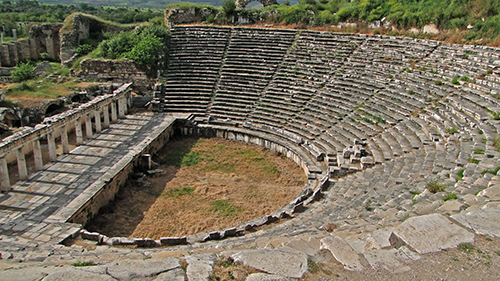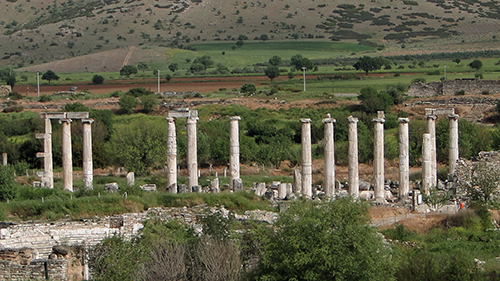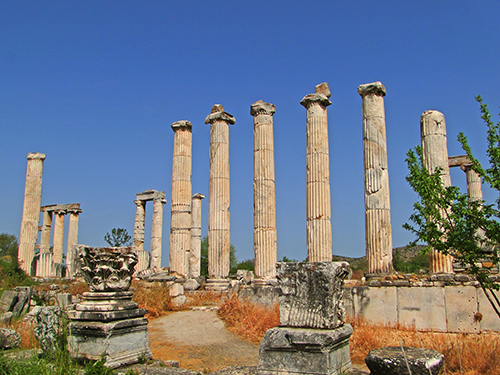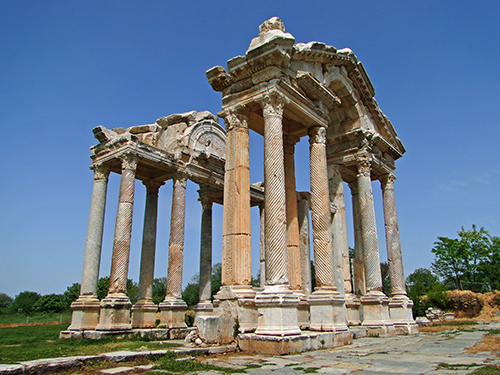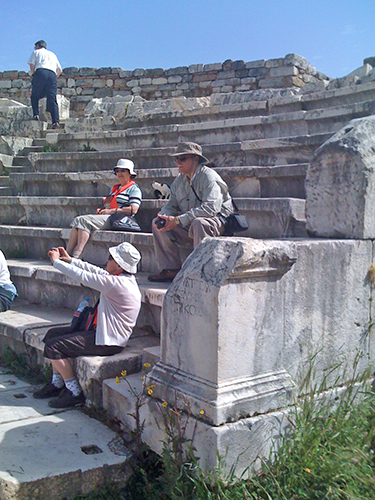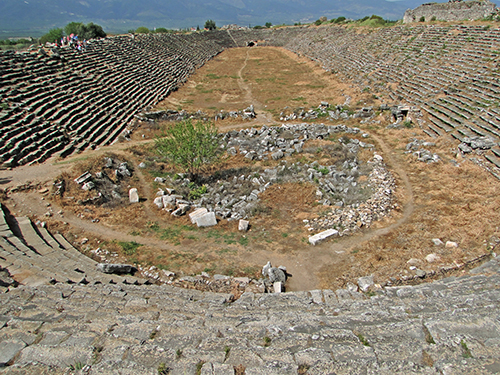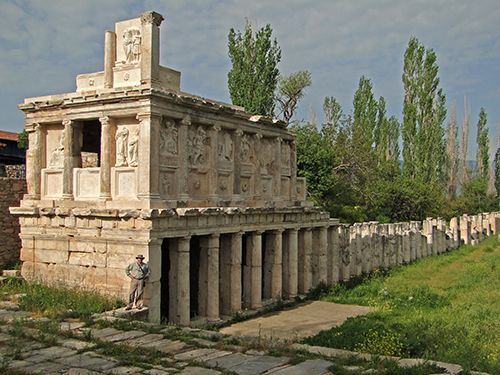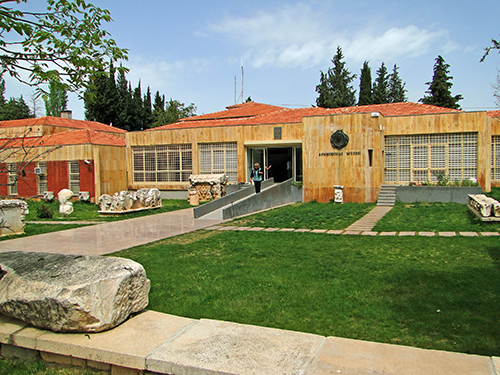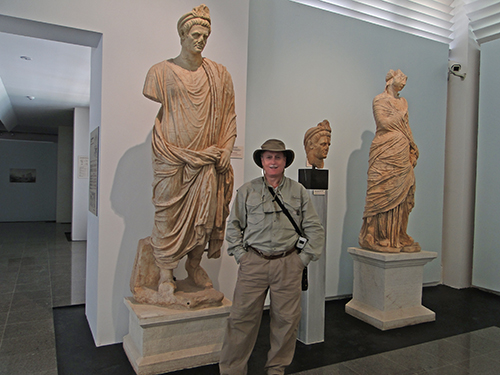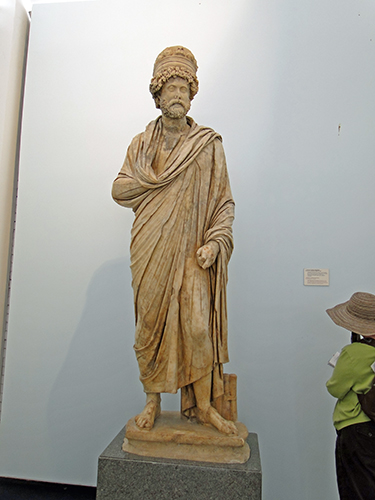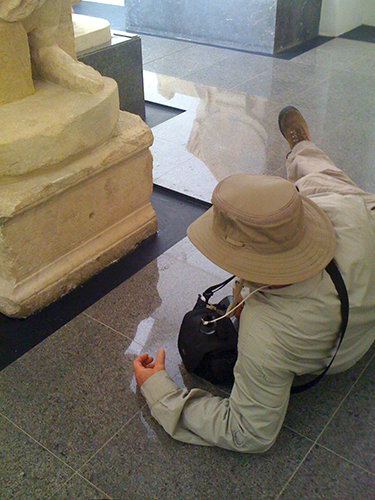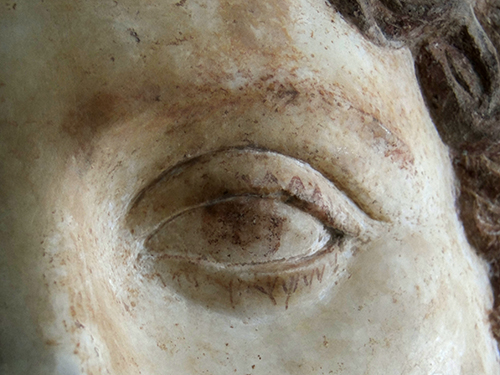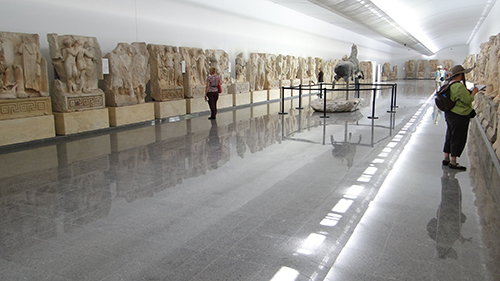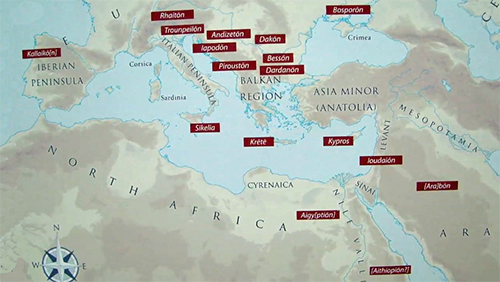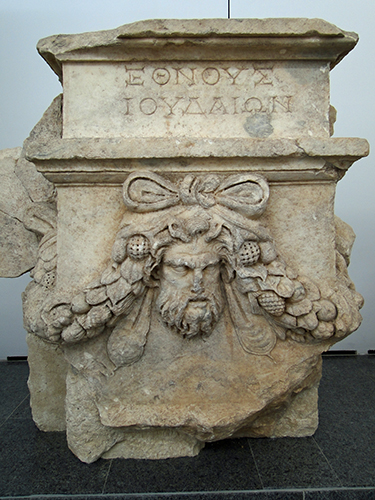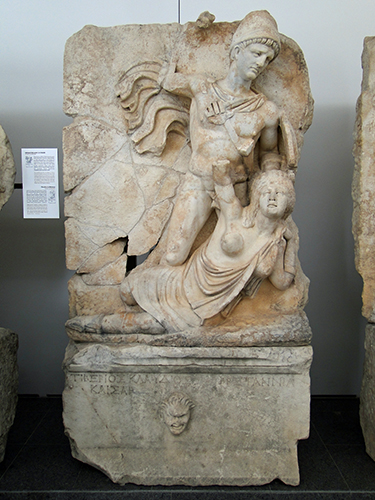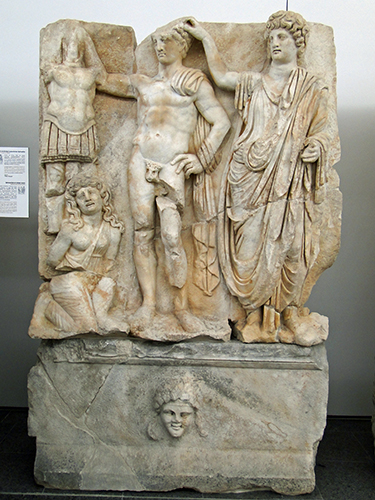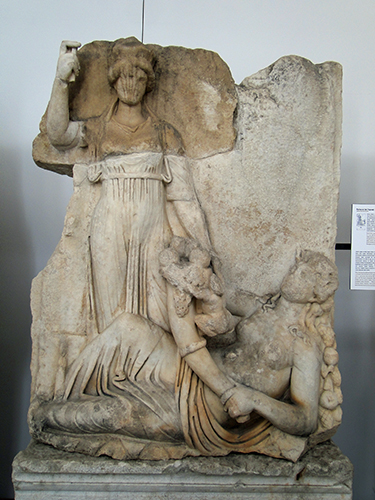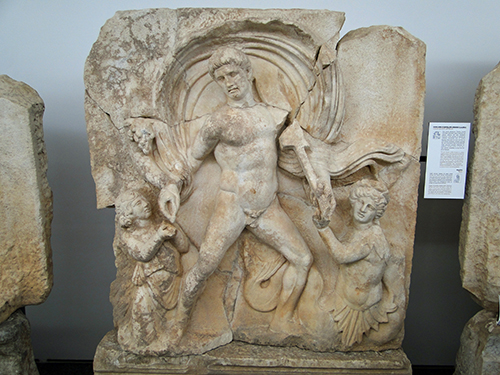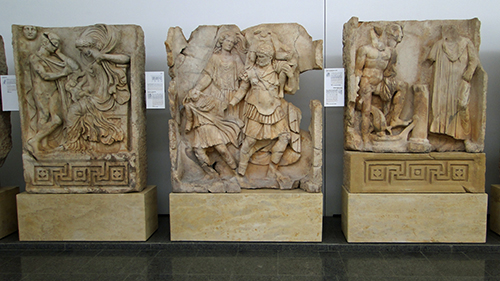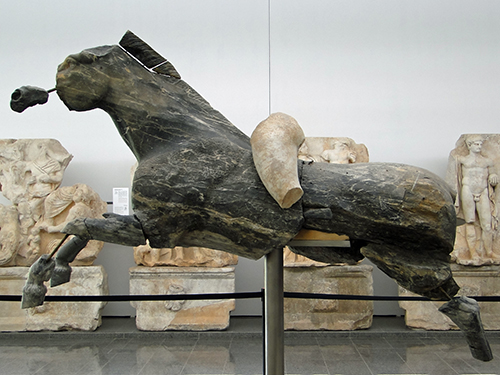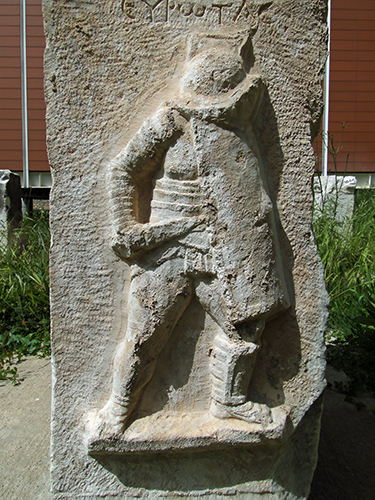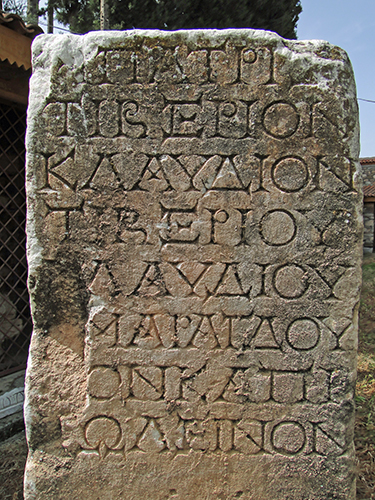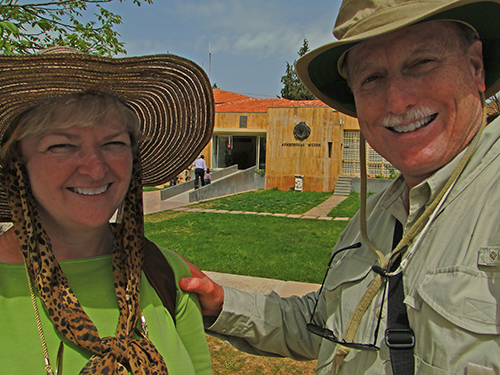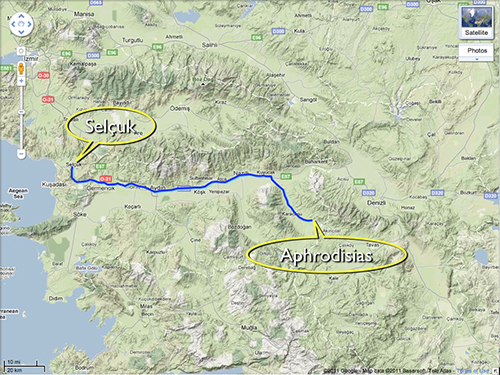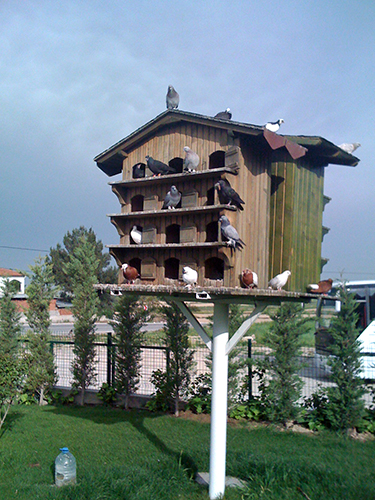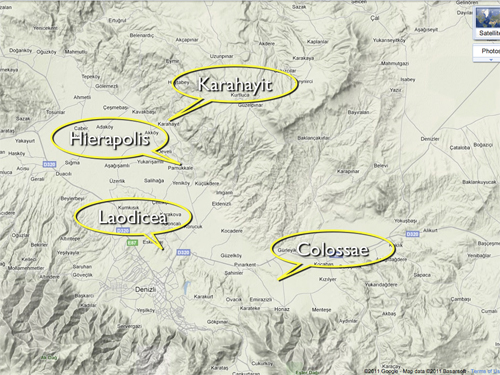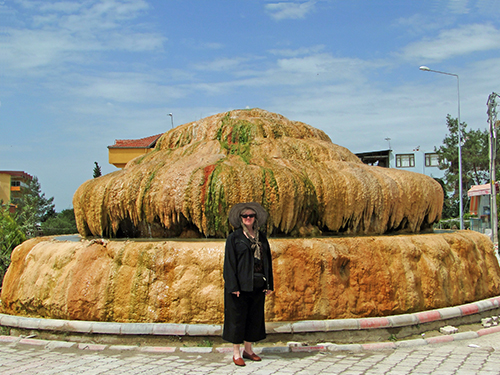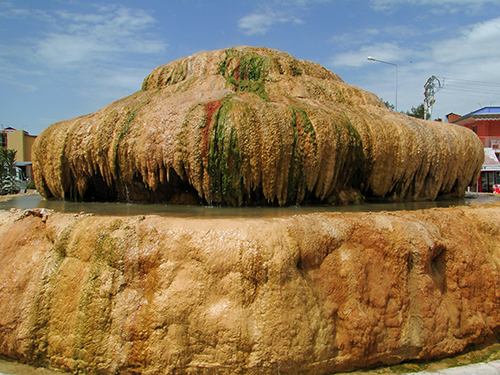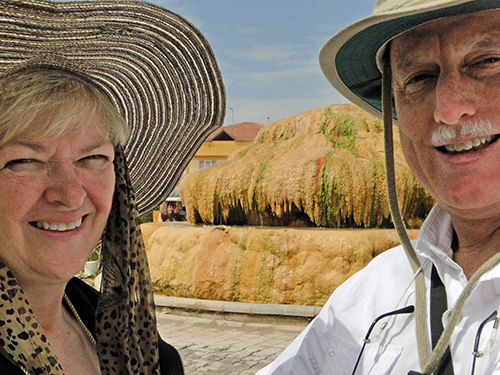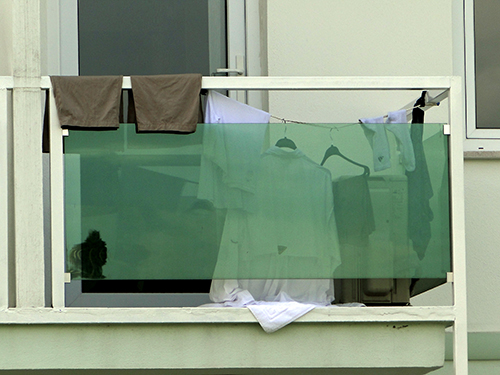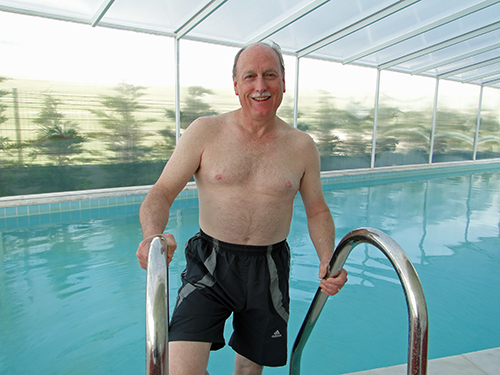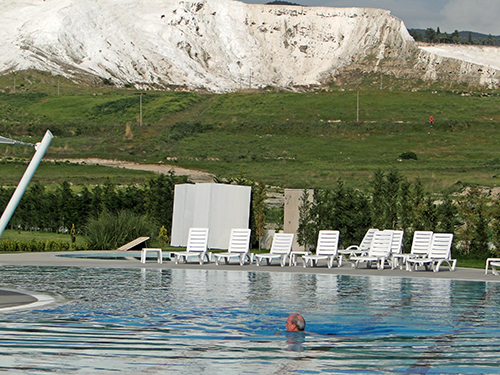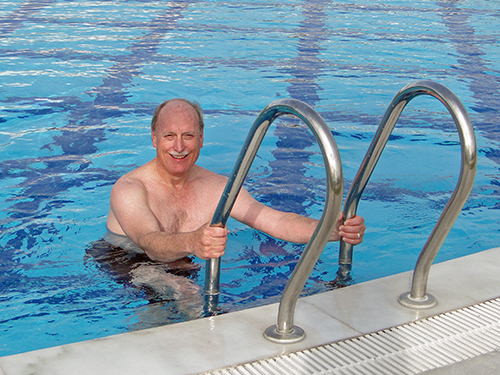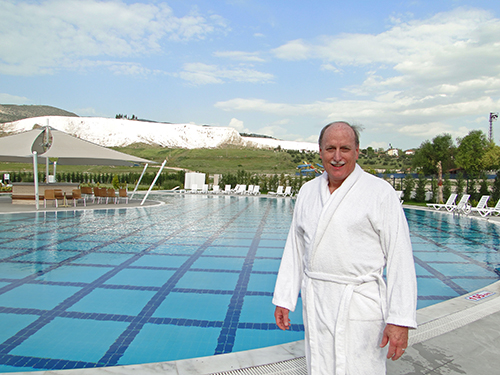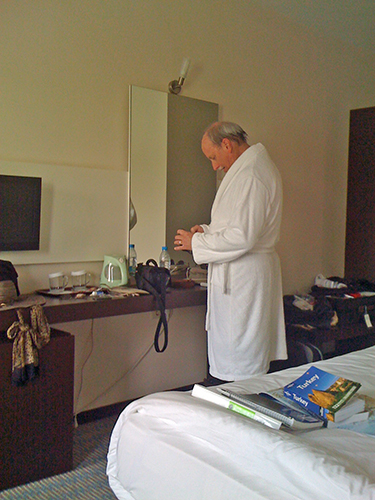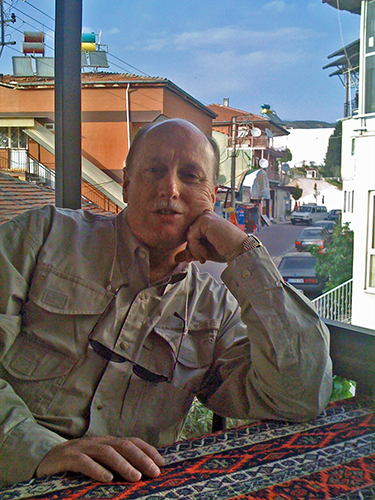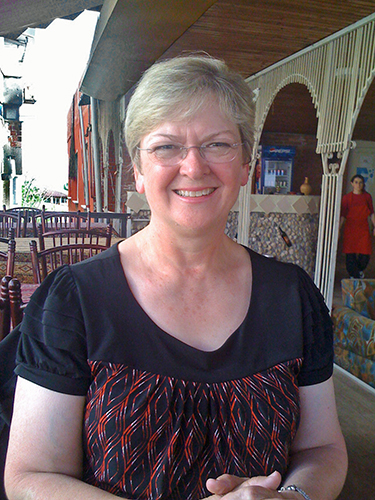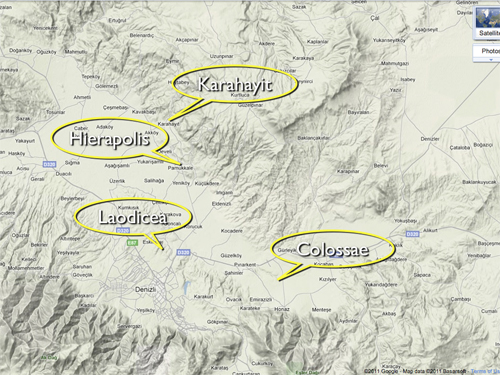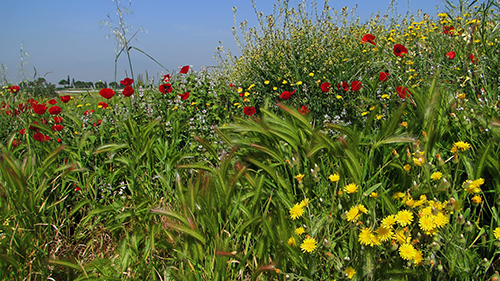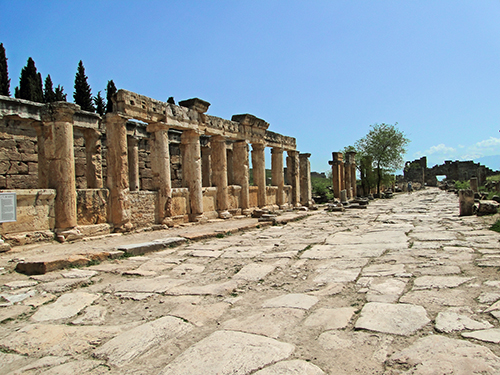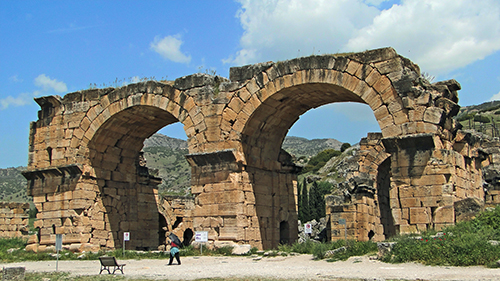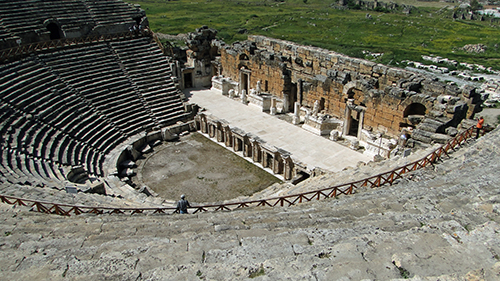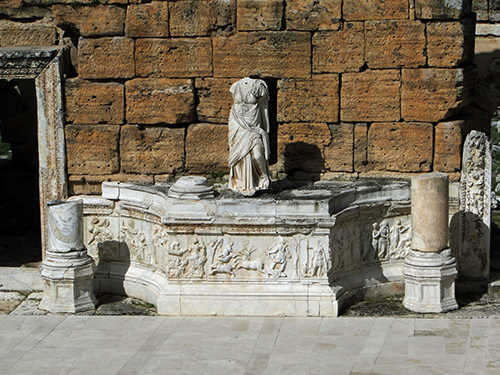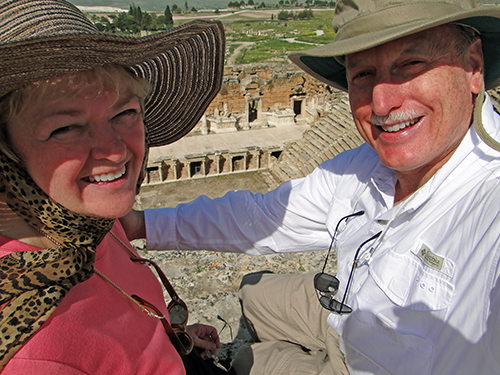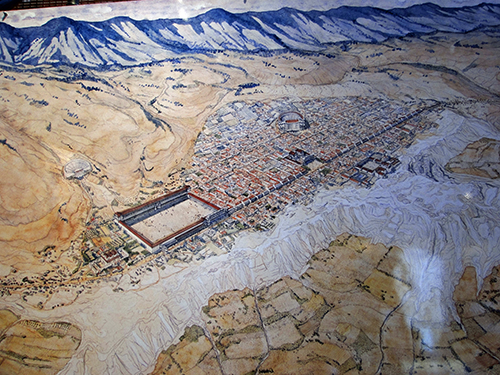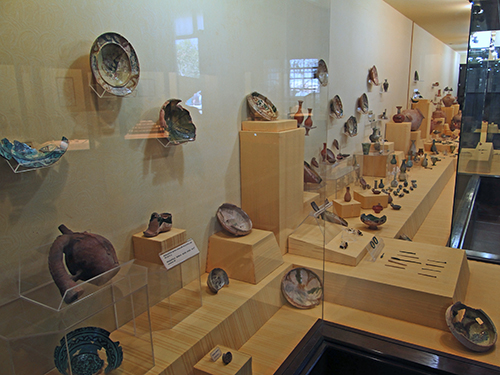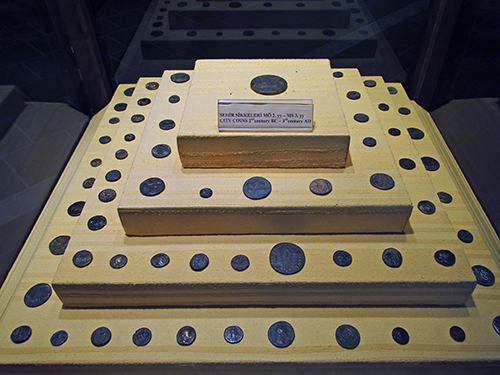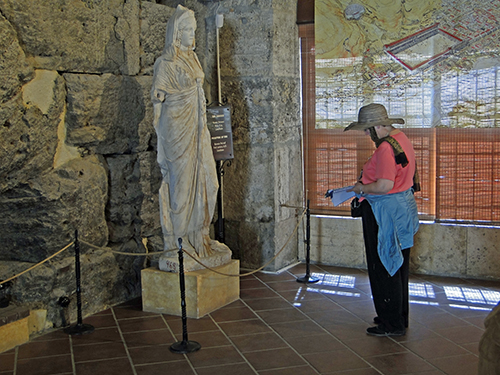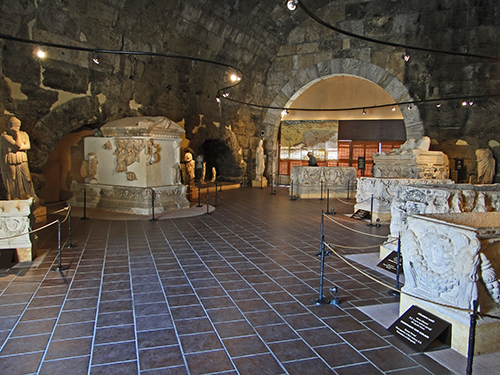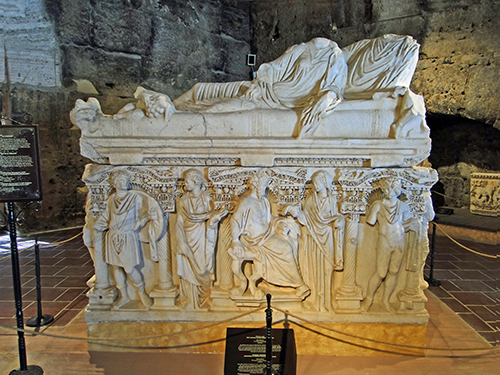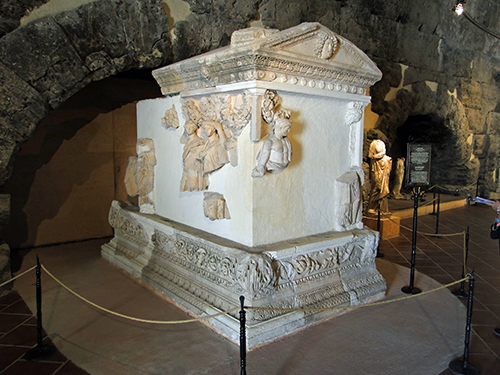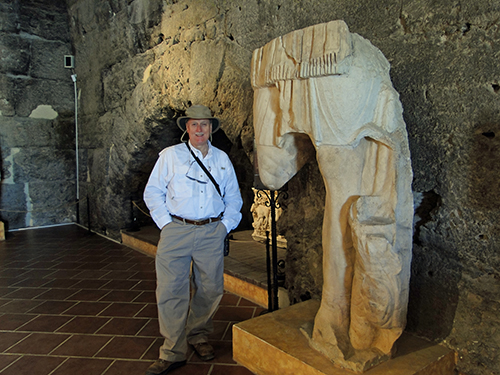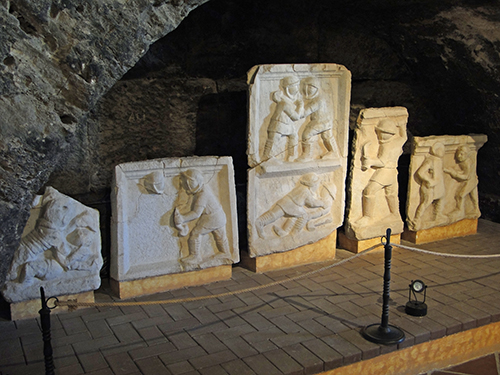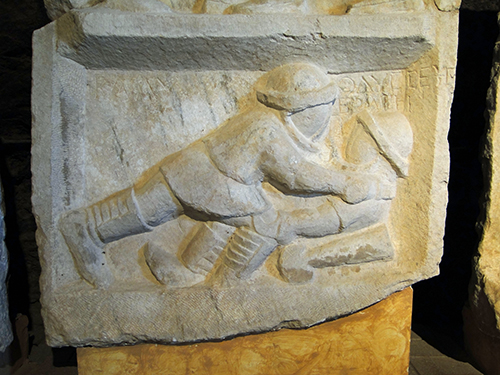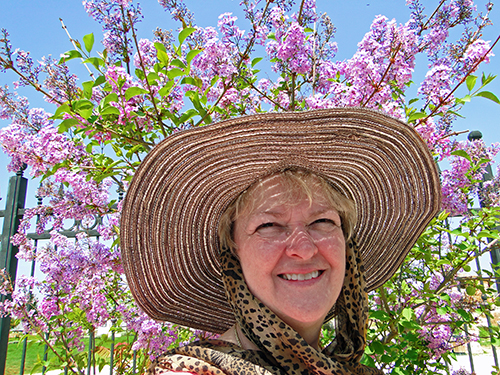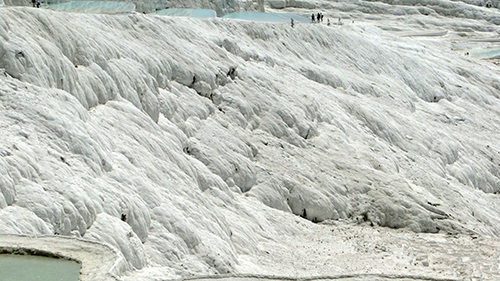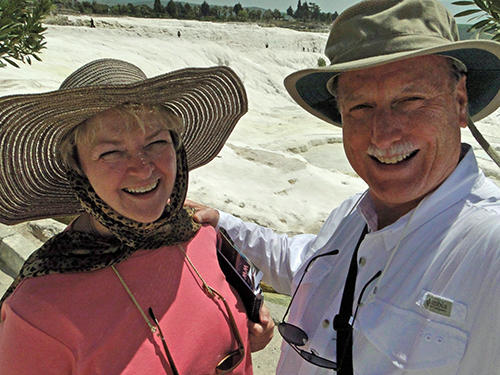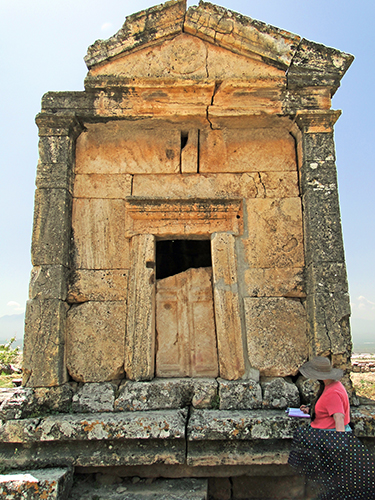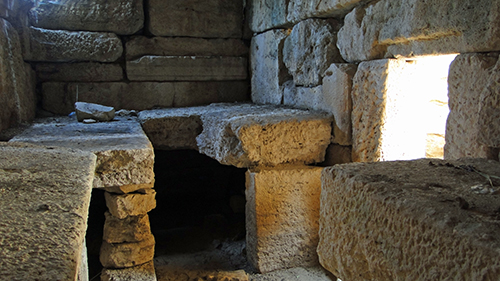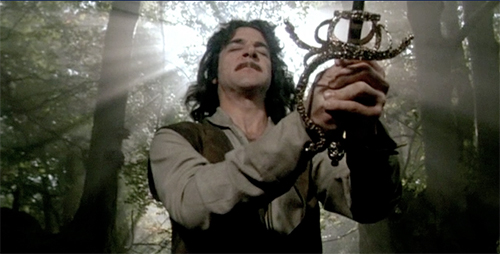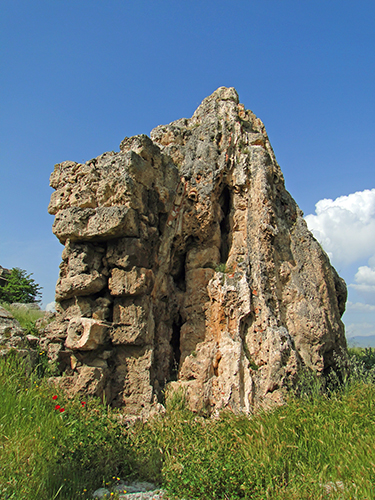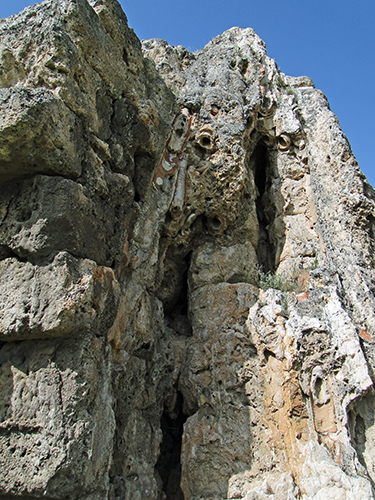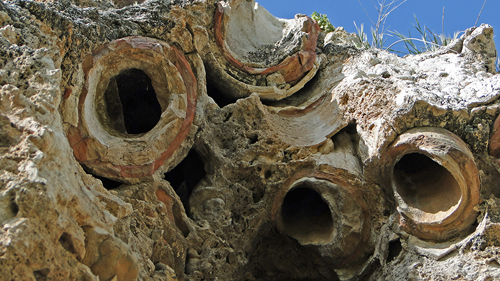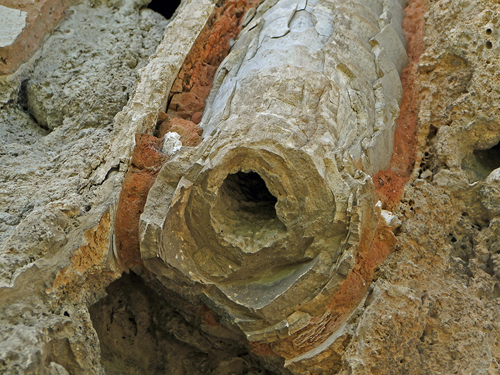Europe & Turkey—Day 19: Aphrodisias
Posted by DrKoineApr 18
April 18, 2010 (Sunday)
On the Road Again. We checked out of our Hotel Tripoli in Pamukkale (Hierapolis) early in the morning in order to carve out some time from a long drive getting to Selçuk (Ephesus). We plan to stop off at the ancient site of Aphrodisias along the way.
Our drive time estimate is sound. We get to Aphrodisias just as the archeological site opens. We stayed at the site about 6 ½ hours.
Aphrodisias. The site is wonderful. Due to the way the site is situated in its topography, you gain a very realistic feel for an ancient city. The reason is because the theater is up high on a hill, and this vantage point offers a great 360 degree overview of the entire site. From the theater overlook, you can see how the city was laid out in the Hippodrome Greek pattern like most cities of the ancient Greco-Roman world, and even like our cities today. The temple of Aphrodite off in the distance is easily spotted from the theater. The majestic entrance to the temple of Aphrodite, called the Tetrapylon, or Monumental Gateway, is seen. The swampy area of the Agora is not immediately evident from the top of the theater until one gets near the location on foot. This Agora must have been beautiful, as the remains show that the entire middle of the interior court was a long pool with fish and aquatic plants fed by a freshwater spring. Just behind the Agora was the Bouleterion, also now filled with water in the middle. The Bouleterion still has the bases of the statuary at the front that honored prominent citizens of Aphrodisias who were generous benefactors or who held important civic offices.
Stadium. The most impressive remains were the stadium (an oblong running and racing track—not the same as a theater) and the Sebastion (Emperor Temple). The stadium was interesting due to being able to see its evolution in use over time. Stadiums originated with the Greeks for their festival games in competitions between cities, serving for foot races, discus throw, etc. At Aphrodisias, the Romans modified the original Greek stadium’s east end in 400 AD for gladiatorial games. In the evolution of the use of the stadium over time, the difference in Greek and Roman cultures is so evident. The Greek stadium represented cultural Greek ideals and athletic prowess. Roman usage turned this stadium and its cultured symbolism into the violent bloodlust of Roman gladiatorial games.
Sebastion. The Sebastion formally was a temple dedicated to Augustus, but more broadly at Aphrodisias was a long, three-storied portico courtyard of the Imperial Temple complex used for Roman imperial propaganda through its reliefs, statuary, and imagery. The Sebastion portrayed Roman propaganda about the Roman Empire in full, powerful expression. The Sebastion of Aphrodisias stands as another reminder of how strong the emperor cult in Asia Minor was at the time the book of Revelation was written. A new wing of the Aphrodisias Museum now houses some of these statuary, reliefs, and images from the Sebastion. Below is an artist’s rendition looking through the entrance gate into the Sebastion porticos and temple at the far end. In the following picture, Jerry is standing in front of the first level of one wing of the Sebastion reconstruction project, which, at the time of our visit, was scheduled for completion sometime in 2011.
Aphrodisias Museum. The Aphrodisias Museum is wonderful. The museum is full of artifacts, especially statuary. In addition, a new room full of first-century AD reliefs from the Sebastion had recently been opened—Jerry was in heaven! The reliefs and artwork had carefully documented descriptions. Jerry takes pictures galore to show Roman imperial propaganda and ideology.
Statuary. The museum had a number of statues that Jerry enjoyed, because some of the dates were first century. First-century anything always cranks his motor. One statue represents a leading citizen of Aphrodisias dated to the first century. He is depicted wearing a priestly crown, a high civic honor, and, hence, a symbol of great status and achievement. You see me taking notes at another honorarium statue, including a priestly crown. Not all statuary is of leading men. One statue of a lady named Domitilla shows she had high status and rank. A statue of Aphrodite does not have the multi-breasted form of the famous one from Ephesus. One of the reasons we take a while to work through these museums is that Jerry wants to translate most of the inscriptions, even if that puts him on the floor.
Most people do not know that the ancient Greeks painted their temples and statuary bright colors. What we see today is just the marble surface with all the paint long gone. The Aphrodisias Museum has a statue of a young athlete done on the scheme of Polykliton Diakophorous that was found in the theater area and dates from the first century B.C. to early first century A.D. Just a hint of the original polychromy still survives in the eyes and the hair.
Sebastion Reliefs. Jerry said the reliefs taken from the porticos of the Sebastion now on display in a new wing of the museum were an incredible treasure trove illustrating Roman imperial propaganda. The new wing is huge. We take a while to work through all the descriptions. I am recording data constantly as Jerry shoots away.
Imperial Propaganda. How did the Romans use statuary and reliefs for imperial propaganda? The images depicted were crucial in their precise content and disposition. For example, in one scene of these reliefs, the god Hemera (Day) has a dramatic billowing cloak framing the head. This billowing cloak forms a type of halo and was standard relief imagery intended to be evocative of a divine ephiphany. The gods reveal themselves to mortals in these epiphanies. No accident, then, that Roman emperors also are pictured with such a billowing halo of the cloak as their victories on the field of battle are depicted. The battlefield victory is interpreted by the imperial propaganda machine as a partial divine epiphany revealing the true nature of the emperor. The early reign of Nero, for example, was associated widely throughout the empire with the sun god Helios. How images are combined also have meaning. For example, the combination of the god Day and the god Night into one image signified the eternity of Roman imperial rule. Again, the combined image of the god Ocean with the god Earth together represented the empire without end, Rome as lord of land and sea.
Victory. On the third story of the south portico of the Sebastion, the subject of the reliefs are the Roman emperors in the context of imperial victories with backgrounds of the Olympian gods. The association with the Olympian gods was to portray the emperors as powerful, warring deities intentionally mixed with the old gods as near-equal partners. The inscription is labeled “Theoi Sebastoi Olympiori,” or “Olympian Emperor Gods.” The main emperors for such imagery were Augustus, Tiberius, Claudius, and Nero. (The madman Gaius, better known as Caligula, conveniently was by-passed.) These emperors’ most important achievements were their victorious wars over the barbarians. The wild, chaotic elements of the world on the edges of the empire are subdued by imperial might, and the Roman civilization that follows brings order, peace, and stability to ever-greater reaches of the world.
Six of the inscribed panels on display in the museum are related specifically to the victories and world empire of Claudius (A.D. 43–54) and Nero (A.D. 54–68). In particular, Claudius is pictured conquering Britannia, and Nero is pictured conquering Armenia, both in the Hellenistic “heroic style.” Britain was considered the “signature” victory of Claudius, and Armenia the “signature” victory of Nero. Together, these two victories represented the imperial conquest to the furtherest east and furtherest west of the empire’s boundaries at the time. The inscription for such images often is “Nike Sebastin,” or “Victory of the Emperors.” Jerry said he could not help but think of so many New Testament passages using this very word for victory, the noun, nike, or the cognate verb, nikao, “to conquer,” such as Paul’s bold words to the Roman believers, “we are more than conquerors” (Rom 8:37), or the dramatic declaration in 1 John 5:4, “for whoever is born of God conquers the world; and this is the victory that conquers the world, our faith.” Thus, a key attribute of imperial rhetoric is victory, and New Testament authors seem intent on coopting this imperial rhetoric.
The second story of the north portico had a series of 50 personifications of places and people from East Africa to Western Spain. These personifications were designed to look like statues between columns of the portico. An example of an inscription would be, “Ethnos Dakon,” which would be, “the people of Dacios.” The idea was a visual listing of the Augustan world empire and places and people who were brought into the empire under Augustus. The concept was borrowed from a monument in Rome. The selection particularly emphasized the wilder people on the edges of the empire. Few in Aphrodisias ever can have heard of many of them. Example places and people are Egyptians, Ethiopians, Andizeti, Arabs, Besse, Bosphorans, Dacians, Dardani, Iapodes, Judeans, Callaeci, Piroristi, Phaeti, Trumpilini, Crete, Cyprus, and Sicily. Jerry particularly was struck by the actual inscription for Judeans, who were subjugated under the general Pompey in 63 B.C.
In the image below, the naked warrior (i.e., Greek “heroic” style) is Claudius, who is about to deliver the death blow to the slumped figure of Britannia. Claudius wears the military symbols of a helmet, cloak, and sword-belt. Britannia wears a tunic with one breast bare (imagery modeled on the fabled, warring Amazons). The inscription reads, “Tiberius Klaudios Kaisar-Bretannia.”
Another relief depicts the direct relationship conceived between the emperor and the Roman people.The emperor is understood as the premier patron of the empire. All citizens are obligated to him for his generous benefaction of peace, security, and prosperity; they should be his adoring and grateful clients. In the relief, the emperor, again, is pictured as a naked warrior (Greek “heroic” style), but here being crowned by a personification of the Roman people wearing a toga, the stately, civilian dress of Roman citizens. The emperor is being crowned with an oak wreath, depicting the “corona civica,” or “civic crown” awarded for saving citizens’ lives by protecting them from the barbarian hordes on the outer fringes of the empire. The emperor is setting up a battlefield trophy. Beneath the trophy in abject humiliation kneels an anguished barbarian woman captive.
Abundance. Another imperial propaganda theme is prosperity and abundance. In this theme, Rome and Earth often are pictured together. In the relief below, Rome holds a spear and wears a crown in the form of a city wall (civilization). Earth reclines, half naked, leaning on an abundance of fruit and holding a cornucopia full of fruit. A baby is climbing up the horn of the cornucopia. Thus is depicted Earth’s fertility and abundance overseen and guaranteed by Rome. In stark contrast, Paul wrote to the Romans and declared that, instead of a cornucopia of abundance, human empires such as Rome had pillaged the earth, and that all of creation was “groaning” for deliverance from futility (Rom 8:19–22).
Notice in the relief below how Claudius is depicted as Master of Land and Sea. In the imagery, the god Claudius strides forward in a divine ephiphany with the drapery billowing around his head. Claudius receives the cornucopia with the fruits of the earth from a figure emerging from the ground. The idea is clear. The god-emperor guarantees the prosperity of land and sea. What is remarkable about this relief is how transparently is portrayed the local appropriation by the inhabitants of Aphrodisias of the emperor’s asserted role as universal divine savior and protector. This city has bought into the imperial propaganda completely—heart, soul, and mind.
Aeneas Legend. Romans used the Greek story of Troy in Homer to explain their origins, thereby arrogating to themselves ancient connections, high status, and great honor. In the image below, the three reliefs from left to right depict the story of the Trojan hero, Aeneas, son of Aphrodite. The first image is the divine conception of Aeneas as son of prince Anchises and the goddess Aphrodite. The second image is Aeneas’s flight from conquered Troy with his son Iulus helped by the goddess Aphrodite. The third image is the arrival of Aeneas and Iulus to Italy to found the city of Rome. Thus, in the Roman telling (Virgil’s Aeneid), the story of the fall of Troy is amplified into a story of Roman origins, because, as the Romans tell the story, Aeneas not only founds Rome but is claimed as the ancestor of Julius Caesar, and, hence, of the entire Augustan imperial family. Since Roman legends of their origin evoked a special relationship between the Greek goddess Aphrodite, the city of Rome, and the Roman imperial family, Roman favoritism toward and benefaction to the city of Aphrodisias throughout her history was assured.
Other Items. The Aphrodisias Museum has the partial remains of a unique blue marble horse. This representation of a large galloping horse in marble is unique among ancient statues. (The usual material used for such statues is bronze.) The subject behind the imagery is the story of Troilos and Achilles.
Outside the museum were grave stele, especially commemorating gladiators, including their personal names. One of these stele had the name “Eurotas” inscribed. Several nice inscriptions were preserved, one of which Jerry found the name of the emperor Claudius in the third line. As we leave the museum grounds, Jerry takes a parting shot of a pretty violet tree in profuse bloom, another reminder from nature of our spring visit to Turkey.
On the Road Again. After we finish the museum, we leave the Aphrodisias site about mid-afternoon, around 3:30–4:00 PM. We head west in a long drive for Selçuk, which is the modern town near the ancient site of Ephesus. We actually have a contact in Selçuk due to Jerry’s networking at the annual meeting of the Society of Biblical Literature. At the SBL annual meeting, Jerry had discovered the Crisler Institute, based in Selçuk, formed by Janet Crisler in honor of the lifelong work of her husband at the site of Ephesus. The Crisler Institute houses the Crisler Library and has lecture halls, study rooms, and accommodations for overnight lodging. The Crisler Institute is where we have our accommodations for our visit to the site of Ephesus. Jerry has been promised great help from Janet for our visit to the Ephesus site and the Ephesus museum. Jerry had asked for a special tour of the elite terrace homes off Curetes Street and to be able to go to the actual site of the recently discovered gladiator burial grounds.
Anybody Home? After several hours driving (that Jerry is a real trouper), we finally arrive in Selçuk. We had no problem finding the Crisler Library address and its entrance gate—but the gate is closed and locked! We ring the bell several times, and wait a long time, but no one answers! Jerry is flabbergasted. He had had numerous email correspondences indicating clearly our expected arrival time in Selçuk, and we had arrived right in that time frame.
Poor Jerry. He feels so bad about our predicament. He is thoroughly confused. He had worked out all the details with Janet Crisler through numerous emails and confirmations. Unfortunately in all this correspondence, Janet never had given Jerry a cell phone contact number. Since the Library obviously was closed, he knew no one to call. Our only contact in Selçuk is nowhere to be found, and we have no backup plan for a place to stay! No one in the world would have thought we would have needed a backup plan. Evening is fast approaching now. So here we are, late on Sunday, the sun soon to set, with no room for the night and not a clue where the nearest hotel might be.
“And now, the rest of the story . . .” Fortunately, help was just up the same street the Crisler Liberary is on. Would you believe, in the very next block of the same street is a small, boutique hotel right next door to the Library? We walk up the street to inquire at the front desk, and, voila! They have a room available. What a huge sigh of relief came from both of us, but especially Jerry. The third-floor room we are shown turns out to be very nice, with a large balcony overlooking a part of ancient Ephesus, the sparse remains of the temple of Aphrodite complex. The bathroom also is nice. Yes! So, we’re okay for tonight. Thank you, Lord. We’ll try to get in touch with Janet Crisler tomorrow when the Institute opens to find out what happened and to move to where we had planned to have our room and board for the entire time we are in Ephesus.
Amazon Bistro. We get a recommendation for dinner from the hotel proprietor. He says straight down the same street of our hotel on past the Crisler Library is the Amazon Bistro with excellent food. We go there and find the restaurant to be very good, including a wonderful Greek salad. You never can go wrong serving Jerry a good Greek salad. After dinner, we walk back up the street to the hotel and head to bed after a really long day. We toss and turn for a while, because we are bursting with curiosity as to what in the world happened to Janet Crisler and the failed Crisler Library connection today that we thought was so secured.
For a video of the Aphrodisias action today:

